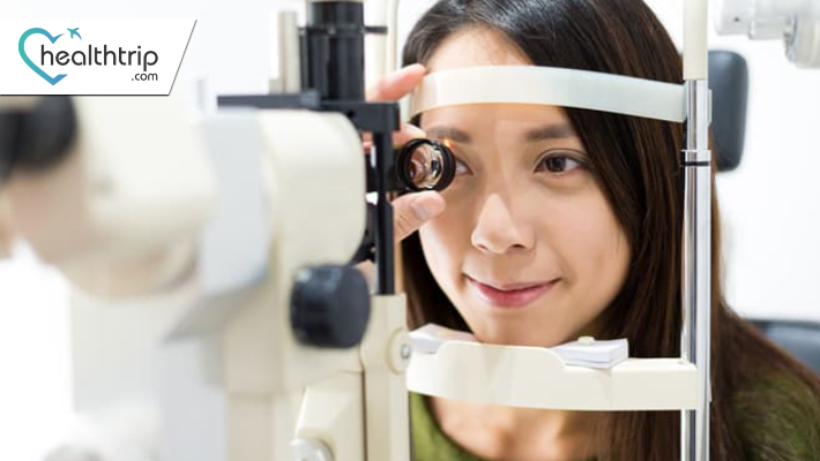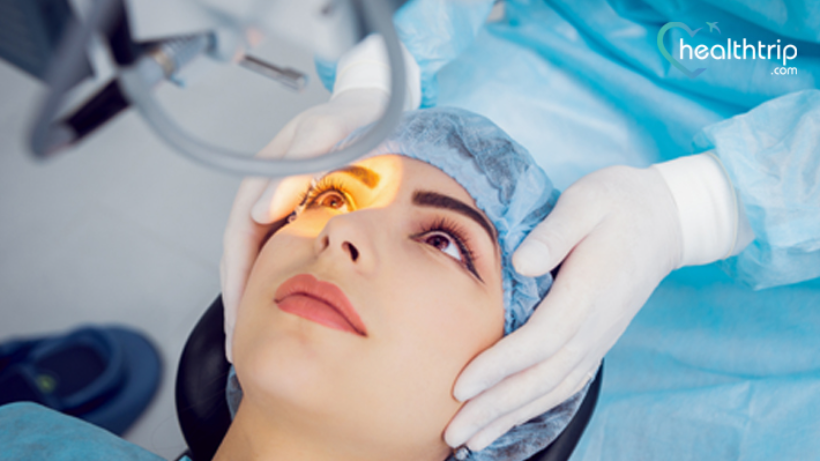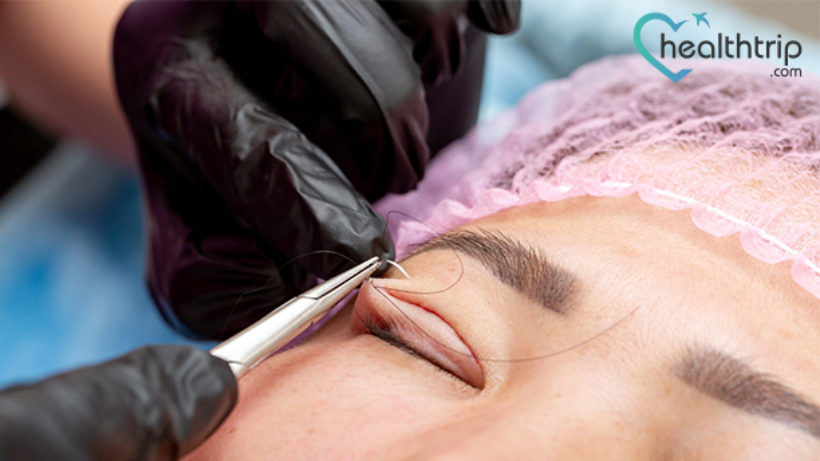The Sight Avenue
New Delhi, India
With advanced diagnostic services and sophisticated ophthalmic surgical setup, The Sight Avenue Hospital offers the patients with world-class quality services. Our set up is the best in Delhi NCR as well as the entire northeast.... read more
Send EnquiryAbout The Hospital
- With advanced diagnostic services and sophisticated ophthalmic surgical setup, The Sight Avenue Hospital offers the patients with world-class quality services. Our set up is the best in Delhi NCR as well as the entire northeast.
- With the help of experienced and dedicated ophthalmologists and eye surgeons of the Delhi region, The Sight Avenue caters super specialty eye treatments and surgeries.
- Starting from the minor procedures to the major eye complications, we are the one-stop solution for everything related to eye health.
- The premium services and the hassle-free payment options ensure a smooth and comfortable experience. We also offer easy EMI benefits along with a huge empanelment of cashless benefit providers.
Treatments Offered
Top Doctors
Medical Director - Opthalmology
CONSULTS AT EXPEREIENCE :17 years SURGERIES :
50000+
Treatment Starting at $600
Free Text ConsultTreatment Starting at $600
17 years SURGERIES :
50000+ TREATMENT COST
Starting at $600
Patient Testimonials
Nearby Guest House
Team & specialisation
What We Offer
- Cataract services
- Cornea services
- Glaucoma services
- Pediatric ophthalmology
- Optical outlets
- Lasik
- Smile
- Retina and uvea services
- Oculoplasty
- Contact lens and low vision aids
Infrastructure

Number Of Beds

Operation Theatres
NA

No Of Surgeon
1
- The Sight Avenue brings the latest eye care technologies in New Delhi. Compared to other hospitals in the area.
- The Sight Avenue uses the most up-to-date technology to ensure the best eye care services for the patients.
- Starting from SMILE, and Femto laser technology to digital retinal imaging and OCT scan.
- The Sight Avenue offers them all to meet your eye care needs.
Blogs

Top Ophthalmologists for Astigmatism Treatment in India
Astigmatism is a common eye condition that causes blurred vision. It occurs when the cornea (the clear front part of the eye) or lens (the clear structure inside the eye that helps focus light) is not perfectly round. This can cause light rays to focus at multiple points inside the eye, rather than on a single point, resulting in blurred vision.There are three main types of astigmatism:Corneal astigmatism: This is the most common type of astigmatism and occurs when the cornea is not perfectly round.Lenticular astigmatism: This type of astigmatism occurs when the lens is not perfectly round.Regular astigmatism: This type of astigmatism occurs when the cornea or lens has a smooth, regular curve.Irregular astigmatism: This type of astigmatism occurs when the cornea or lens has an irregular curve.Astigmatism can be treated with a variety of methods, including:Eyeglasses or contact lenses: Eyeglasses and contact lenses can correct astigmatism by bending light rays so that they focus correctly on the retina (the light-sensitive tissue at the back of the eye).Refractive surgery: Refractive surgery is a surgical procedure that can reshape the cornea so that it can focus light correctly. The two most common types of refractive surgery for astigmatism are LASIK and PRK.Corneal implants: Corneal implants are thin plastic rings that can be implanted in the cornea to change its shape and correct astigmatism.The best treatment for astigmatism will depend on the severity of your condition and your personal preferences. If you have mild astigmatism, you may not need any treatment. However, if your astigmatism is more severe, you may need to wear eyeglasses or contact lenses, or have refractive surgery.Dr. Suraj MunjalMedical Director - OphthalmologyConsults at : The Sight AvenueDr. Suraj Munjal Greater Kailash in Delhi is home to renowned ophthalmologists.He has 18 years of experience as an ophthalmologist in practice. He holds an MBBS and MS in ophthalmology. He is presently employed for The Sight Avenue Hospital in Delhi's Greater Kailash.Dr. Suraj Munjal is the Founder & Chief Medical Officer of Spectra Eye group of Hospitals. Dr. Munjal has always wanted to provide the best eye care services in India & abroad at a very affordable cost with personalized touch without any compromise on the ethics. He has traveled to Middle East countries like Iraq, Dubai, Kurdistan, Bahrain etc. for surgeries on invitation of the local Governments. Cataract surgeryLASIK surgeryRefractive surgeryCorneal surgeryAstigmatismEye muscle surgeryOculoplastic surgeryEyelid surgeryOrbital surgeryAnterior segment surgeryVitreoretinal surgeryDr. Vikas VeerwalOphthalmologistConsults at : Centre For SightDr Vikas has 8 years of experience in Ophthalmology, Dr Vikas excels in advanced cataract surgery techniques (including Femto-Cataract and MICS- Micro-incision cataract surgery), refractive surgeries (including ICL, SMILE, LASIK, PRK) as well as all corneal procedures. He has performed more than 300 corneal transplants and has immense experience in all forms of advanced corneal surgeries like DALK, DSAEK and DMEK. Keratoconus and corneal ectasia has been his key areas of interest. Areas of interest. Refractive surgeryCorneal surgeryAstigmatism Dr Sunita ChaurasiaConsultant, Cornea & Anterior Segment, Refractive And Pediatric Cornea Services Medical Director Of The Ramayamma International Eye BankConsults at : L V Prasad Eye InstituteSunita Chaurasia did her fellowship in cornea and anterior segment at LV Prasad Eye Institute, Hyderabad (2006-2007) and overseas fellowship in advanced corneal procedures at the renowned Price Vision Group, Indianapolis, USA (2013). She had her basic medical training from Lokmanya Tilak Medical College, Mumbai (1996-2002) followed by residency in ophthalmology at King Georges’s Medical University, Lucknow (2003-2006).Her clinical areas of specialization are Advanced corneal surgery, Cataract, Refractive surgery, Pediatric corneal surgery, Infective keratitis and Eyebanking. Her basic research interests are Corneal endothelium, Fuch’s endothelial dystrophy and other endothelial disorders. In 2014, she received Achievement award at the American Academy of Ophthalmology. She has published several articles in peer-reviewed journals, authored several books and presented papers at international and national forums. She is a reviewer for several national and international journals.Areas of interest.Advanced corneal surgery, AstigmatismCataract, Refractive surgery,Pediatric corneal surgery,Infective keratitis and Eyebanking. Dr Anita SethiDirector - OphthalmologyConsults at : Fortis Memorial Research Institute, GurgaonDr. Anita Sethi is an experienced surgeon, she has chaired numerous sessions and conducted workshops at a national level in the various aspects of Eyelid and Orbital surgery. She is known among the best ophthalmologists in India.She is proficient in anterior segment surgery including Phacoemulsification surgery LASIK and also has a keen interest in Orbital and Oculoplastic surgery.Dr. Sethi is responsible for establishing the Ophthalmic services at Artemis health institute, Gurgaon & Nova Specialty Hospitals, New Delhi.

How to Protect Your Eyes from Digital Strain
Our reliance on screens has reached unprecedented heights in today's fast-paced digital world. From smartphones and laptops to tablets and e-readers, our daily lives revolve around digital devices. While these technological marvels offer convenience and connectivity, they also bring along a hidden menace – digital eye strain. The increased screen time can take a toll on our eyes, leading to discomfort, fatigue, and even long-term vision problems. Fortunately, leading ophthalmologists have weighed in on this issue, offering invaluable insights into how we can safeguard our eyes from digital strain. In this article, we'll explore their expert tips and advice to help you maintain healthy eyes in the digital age.Understanding Digital Eye StrainBefore delving into the solutions, it's important to grasp the nature of the problem. Digital eye strain, also known as computer vision syndrome, refers to the discomfort and strain that arise after extended periods of screen use. Symptoms can include dry eyes, blurred vision, headaches, neck and shoulder pain, and difficulty focusing. The blue light emitted by screens is a major culprit, as it can disrupt our sleep-wake cycle and contribute to eye strain. With this understanding, let's move on to the actionable steps recommended by leading ophthalmologists.1. The 20-20-20 Rule: Take Regular BreaksOne of the most universally endorsed strategies is the 20-20-20 rule. For every 20 minutes of screen time, take a 20-second break and look at something 20 feet away. This simple practice helps to relax your eye muscles and reduce strain. Ophthalmologists recommend setting reminders on your devices to prompt you to follow this rule, ensuring you don't get caught up in long stretches of continuous screen use.2. Proper Lighting and Screen SettingsOptimal lighting plays a significant role in reducing digital eye strain. Ophthalmologists advise that your screen should be neither too bright nor too dim. Adjust the brightness to match the lighting conditions in your environment. Additionally, consider reducing the blue light emitted by your device by using blue light filters or special screen protectors. Many devices also come with built-in "night mode" settings that reduce blue light emissions during evening hours, which can contribute to better sleep as well.3. Ergonomic SetupCreating an ergonomic workstation can greatly alleviate eye strain. Ensure that your screen is at eye level, about 20 to 24 inches away from your face. Position your chair and desk to promote good posture, which can help reduce strain on your neck, shoulders, and back. This setup not only benefits your eyes but also contributes to overall comfort and productivity.4. Blink Frequently and Stay HydratedDigital activities often lead to decreased blink rates, which can cause dry eyes. Ophthalmologists recommend consciously blinking more often to keep your eyes moist and comfortable. Additionally, staying hydrated by drinking plenty of water throughout the day helps maintain optimal eye moisture levels.5. Regular Eye ExamsRoutine eye check-ups are crucial, even if you're not experiencing noticeable vision problems. Ophthalmologists can detect early signs of eye strain and provide personalized recommendations. They can also prescribe specialized glasses or contact lenses designed to reduce digital eye strain and enhance visual comfort during screen use.6. Follow the 20-20-8 Rule for ChildrenChildren's eyes are particularly susceptible to the effects of prolonged screen time. Ophthalmologists suggest the 20-20-8 rule for kids: after 20 minutes of screen use, have them take a 20-second break and focus on something at least 8 feet away. This practice helps prevent digital eye strain and supports healthy visual development.7. Incorporate Eye ExercisesJust as our bodies benefit from regular exercise, our eyes do too. Ophthalmologists recommend simple eye exercises to relax eye muscles. For example, try focusing on a near object for a few seconds, then shift your gaze to a distant object. Repeat this exercise a few times to help maintain flexibility and reduce strain.8. Consider Computer GlassesComputer glasses, also known as blue light-blocking glasses, have gained popularity as a tool to reduce digital eye strain. These glasses filter out a significant portion of blue light, helping to protect your eyes during extended screen time. Consult with an ophthalmologist to determine if computer glasses are a suitable option for you.ConclusionOur reliance on digital devices is unlikely to wane, but with the guidance of leading ophthalmologists, we can minimize the adverse effects of digital eye strain. By adopting these expert-recommended strategies – from the 20-20-20 rule and proper lighting to ergonomic setups and regular eye exams – you can safeguard your eyes and maintain healthy vision in the digital age. Remember, prioritizing your eye health today will pay off with improved comfort, productivity, and long-term visual well-being.Read more: The Latest Advances in Ophthalmology

Affordable Eye Surgery in India - Cost & Procedure Details
India has become a leading destination for affordable and high-quality medical treatment, including eye surgery. With world-class hospitals and highly skilled ophthalmologists, India offers a range of eye surgeries at a fraction of the cost compared to western countries. In this blog, we will discuss the cost and procedure details of affordable eye surgery in India.Types of Eye Surgeries Available in India:Cataract Surgery: Cataract surgery is one of the most commonly performed eye surgeries in India. It involves removing the cloudy lens from the eye and replacing it with a clear artificial lens. The cost of cataract surgery in India ranges from USD 500 to USD 920.Manual Small Incision Cataract Surgery (MSICS): This technique is used in cases where phacoemulsification is not possible due to advanced cataracts or other complications. The surgeon makes a slightly larger incision in the eye and removes the cloudy lens manually. The clear artificial lens is implanted in the same way as in phacoemulsification.LASIK Surgery: LASIK is a laser-assisted surgery used to correct refractive errors like myopia, hyperopia, and astigmatism. The cost of LASIK surgery in India ranges from USD 750 to USD 1200 per eye.Bladeless LASIK: In this technique, a femtosecond laser is used to create a thin corneal flap, which is then lifted to allow the laser to reshape the cornea. This technique is considered safer and more precise than traditional LASIK.Glaucoma Surgery: Glaucoma is a condition that damages the optic nerve of the eye, leading to blindness if left untreated. Glaucoma surgery involves reducing the intraocular pressure to prevent further damage to the optic nerve. The cost of glaucoma surgery in India ranges from USD 900 to USD 1,700 per eye.Glaucoma Drainage Devices: These are small tubes implanted in the eye to help drain excess fluid and reduce intraocular pressure. This technique is used in cases where trabeculectomy is not effective.Corneal Transplant: Corneal transplant is a surgical procedure used to replace a damaged cornea with a healthy one from a donor. The cost of a corneal transplant in India ranges from USD 1600 to USD 2000 per eye.Procedure Details:Consultation: The first step towards eye surgery in India is to consult an ophthalmologist. They will conduct a thorough eye examination and determine the best course of treatment.Preoperative Preparation: The ophthalmologist will guide you through the pre-operative preparations like stopping the use of contact lenses, eye drops, and medication a few days before the surgery.Surgery: The surgery is performed under local anesthesia, and the patient is conscious throughout the procedure. Depending on the type of surgery, the duration can vary from 15 minutes to an hour.Post-Operative Care: After the surgery, the patient needs to follow the ophthalmologist's instructions for post-operative care, including using eye drops, avoiding strenuous activities, and wearing an eye patch.Conclusion:India offers affordable eye surgery with world-class facilities and highly skilled ophthalmologists. The cost of eye surgery in India is significantly lower than in western countries, making it a preferred destination for medical tourists. However, it is essential to do proper research and choose a reputed hospital and an experienced ophthalmologist for a successful outcome.

From Procedure to Cost: Here’s All You Need to Know About Ptosis Surgery
OverviewIf you feel you have a sagging or drooping eyelid interfering with your vision, then you might need ptosis surgery. It's an operation that is done to tighten the muscle that lifts your eyelid. Although this condition might not cause any serious problems, it might cause tiredness, headaches, and cosmetic problems that affect your looks. Here we’ve discussed a few facts you need to know about ptotic surgery so that you can make an informed decision before undergoing the same. What are the benefits of ptosis surgery? Your eyelid position should improve, and your face should appear younger. If your eyelid is obstructing your vision, it should improve.What’s involved in the procedure?The procedure is usually performed under a local anesthetic that is injected into your eyelid and administered as eye drops. The procedure usually takes 45 to 90 minutes, depending on whether both of your upper eyelids are being operated on.Typically, your surgeon will make a cut in the natural skin crease of your eyelid. They will use stitches to strengthen the levator muscle's attachment to your eyelid and to adjust the height of your eyelid.Also, read - 7 Best Lasik Eye Surgery Centers in IndiaAre there any complications associated with the surgery?Like every surgery, ptosis surgery also comes with a set of complications. However, most of them are preventable. The following are some specific and general complications associated with ptosis surgery. Pain Infection at the surgical site Allergic reaction to medicines or anesthesia Overcorrection occurs when your eyelid is lifted too high; under-correction occurs when your eyelid is not lifted sufficiently, and bleeding into your eye socket occurs. Abrasion of the cornea Cosmetic issues Also, read - 7 best eye hospitals in IndiaPtosis surgery costs in IndiaThe minimum cost of ptosis surgery is Rs. 24000 and the average cost of the same is around Rs. 29000. However, the costs can vary based on multiple factors, like :-the severity of the condition-the experience and skill of your surgeon-the location of the hospital-patient's overall health Also, read - Lazy Eye: What is It? Diagnosis, Treatment Options All You Need to KnowHow long do you need to recover after surgery? After a few hours, you should be able to go home. You should avoid getting your eyelids wet, doing strenuous exercise, or bending down until the stitches are removed. For a few weeks, avoid wearing eye makeup or drinking alcohol, and keep your face out of the sun. For the next four weeks, avoid swimming. Regular exercise should help you get back to your normal routine as soon as possible. Before you begin exercising, seek advice from your healthcare team or your primary care physician. Ptosis surgery produces long-term results. Your face will continue to age, but it will always appear younger than it would have if you had not had surgery.Make an appointment with your doctor before undergoing Ptosis surgery. Ptosis surgery is available at a plastic surgery hospital. There are numerous hospitals in your city where you can have Ptosis surgery performed. Our health trip advisors will help you find a good and experienced surgeon. Our experts will ensure that the Ptosis surgery goes smoothly. Also, read - Laser Treatment for GlaucomaWhat can you expect after surgery?The doctor will explain how to care for the eye after surgery. It is critical for the patient to return to the doctor following surgery so that the results can be verified.Appointments are typically scheduled a few days to a week after surgery.Sometimes the eyelid will droop slightly or will not close completely. If the doctor notices this, he or she may recommend additional treatment. However, the eyelid is usually in a better position soon after the operation.How can we help with the treatment? If you are in search of droopy eyelid treatment in India, our medical trip advisors will serve as your guide throughout the treatment. They will be physically present with you even before the medical treatment begins. The following will be provided to you: Opinions of expert physicians and surgeons Transparent communication Coordinated care Prior appointment with specialists Assistance with hospital formalities 24*7 availability Arrangement for travel Assistance for accommodation and healthy recovery Assistance in emergencies We are dedicated to offering the highest quality medical tourism in India to our patients. We have a team of highly qualified and devoted health trip advisors who will be by your side from the beginning of your journey.





